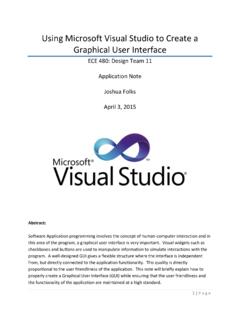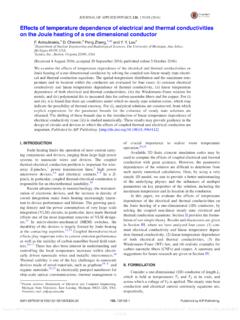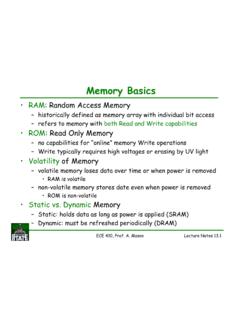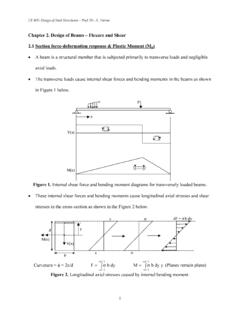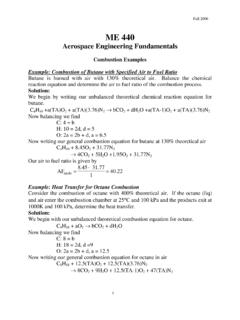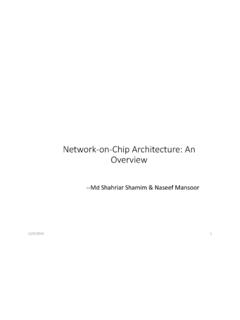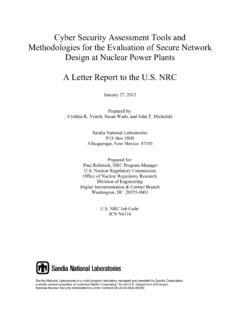Transcription of Chapter 12: Network Management - Michigan State University
1 Chapter 12: Network ManagementJian Ren and Tongtong Li, Michigan State UniversityIntroduction2 OSI Network Management Model ..3 Network Management Layers ..4 ISO Network Management Functions6 Configuration Management ..6 Fault Management ..6 Security Management ..7 Accounting Management ..7 Performance Management ..7 Network Management Protocols7 SNMP/SNMPv1 ..8 SNMPv2 ..13 SNMPv3 ..15 Remote Network Monitoring (RMON) 23 Network Management Tools24 Network Monitors ..25 Network Scanners ..25 Packet Filters ..26 Wireless Network Management26 Cellular Networks ..27 Location Management for CellularNetworks ..28 Policy-based Network Management29 What Is a Policy? ..30 Benefits of PBNM ..31 architecture of a PBNM System.
2 31 Conclusion32 Glossary33 Acknowledgements34 Acronyms37 Abstract: The continuous growth in scale and diversity of computer networks and networkcomponents has made Network Management one of the most challenging issues facing networkadministrators. It has become impossible to carry out Network Management functions withoutthe support of automated tools and applications. In this Chapter , the major Network managementissues, including Network Management requirements, functions, techniques, security, some well-known Network Management protocols and tools, will be discussed. Location Management for thewireless cellular networks will also be briefly described. Finally, policy-based Network Management ,which is a promising direction for the next generation of Network Management , will be.
3 Network Management , Simple Network Management Protocol (SNMP), Struc-ture of Management Information (SMI), Management Information Base (MIB), Remote NetworkMonitoring (RMON), Network monitor, Network scanner, packet filter, policy-based Network man-agement (PBNM)1 IntroductionNetwork Management , in general, is a service that employs a variety of protocols, tools, applications,and devices to assist human Network managers in monitoring and controlling of the proper networkresources, both hardware and software, to address service needs and the Network transmission control protocol/internet protocol (TCP/IP) was developed, little thoughtwas given to Network Management . Prior to the 1980s, the practice of Network Management waslargely proprietary because of the high development cost.
4 The rapid development in the 1980stowards larger and more complex networks caused a significant diffusion of Network managementtechnologies. The starting point in providing specific Network Management tools was in Novem-ber 1987, when Simple Gateway Monitoring Protocol (SGMP) was issued. In early 1988, theInternet architecture Board (IAB) approved Simple Network Management Protocol (SNMP) as ashort-term solution for Network Management . Standards like SNMP and Common Management In-formation Protocol (CMIP) paved the way for standardized Network Management and developmentof innovative Network Management tools and Network Management system(NMS) refers to a collection of applications that enable networkcomponents to be monitored and controlled.
5 In general, Network Management systems have thesame basic architecture , as shown in Figure The architecture consists of two key elements:a managing device, called amanagement station, or amanagerand the managed devices, calledmanagement agentsor simply anagent. A Management station serves as the interface between thehuman Network manager and the Network Management system. It is also the platform for man-agement applications to perform Management functions through interactions with the managementagents. The Management agent responds to the requests from the Management station and alsoprovides the Management station with unsolicited the diversity of managed elements, such as routers, bridges, switches, hubs and so on,and the wide variety of operating systems and programming interfaces, a Management protocolis critical for the Management station to communicate with the Management agents and CMIP are two well-known Network Management protocols.
6 A Network managementsystem is generally described using the Open System Interconnection (OSI) Network managementmodel. As an OSI Network Management protocol, CMIP was proposed as a replacement for theDisplayNetwork Management ApplicationAgentAgentAgentManaged DeviceManaged DeviceManaged DeviceNetwork Management ProtocolNetworkFigure : Typical Network Management architecture [1]simple but less sophisticated SNMP; however, it has not been widely adopted. For this reason, wewill focus on SNMP in this OSI Network Management ModelThe OSI Network Management comprises four major models [2]: Organization Modeldefines the manager, agent, and managed object. It describes thecomponents of a Network Management system, the components functions and infrastructure.
7 Information Modelis concerned with the information structure and storage. It specifiesthe information base used to describe the managed objects and their relationships. TheStructure of Management Information (SMI) defines the syntax and semantics of managementinformation stored in the Management Information Base (MIB). The MIB is used by both theagent process and the manager process for Management information exchange and storage. Communication Modeldeals with the way that information is exchanged between theagent and the manager and between the managers. There are three key elements in thecommunication model: transport protocol, application protocol and the actual message to LinkPhysicalLayer 1 Layer 2 Layer 3 Layer 4 Layer 5 Layer 6 Layer 7 Network Interface and HardwareTCP/UDPI nternetworkApplicationOSI ModelTCP/IP ModelNot presentedin this modelFigure : The OSI and TCP/IP Reference Models Functional Modelcomprises five functional areas of Network Management , which are dis-cussed in more detail in the next Network Management LayersTwo protocol architectures have served as the basis for the development of interoperable communi-cations standards.
8 The International Organization for Standardization (ISO) OSI reference modeland the TCP/IP reference model, which are compared in Figure [3]. The OSI reference modelwas developed based on the promise that different layers of the protocol provide different servicesand functions. It provides a conceptual framework for communications among different networkelements. The OSI model has seven layers. Network communication occurs at different layers,from the application layer to the physical layer; however, each layer can only communicate with itsadjacent layers. The primary functions and services of the OSI layers are described in Table OSI and TCP/IP reference models have much in common. Both are based on the conceptof a stack of independent protocols.
9 Also, the functionality of the corresponding layers is , the difference does exist between the two reference models. The concepts that arecentral to the OSI model include service, interface, and protocol. The OSI reference model makesthe distinction among these three concepts explicit. The TCP/IP model, however, does not clearlydistinguish among these three concepts. As a consequence, the protocols in the OSI model arebetter hidden than in the TCP/IP model and can be replaced relatively easily as the technologychanges. The OSI model was devised before the corresponding protocols were invented. Therefore,Table : OSI Layers and FunctionsLayerFunctionsApplication Provides the user application process with access to OSI facilitiesPresentation Responsible for data representation, data compression, data encryption anddecryption Ensures communication between systems with different data representation Allows the application layer to access the session layer servicesSession Allows users on different machines to establish sessions between them Establishes and maintains connections between processes, and data transferservicesTransport Establishes, maintains and terminates connections between end systems Provides reliable, transparent data transfer between end systems.
10 Or hosts Provides end-to-end error recovery and flow control Multiplexes and de-multiplexes messages from applicationsNetwork Builds end-to-end route through the Network Datagram encapsulation, fragmentation and reassembly Error handling and diagnosticsData Link Composed of two sublayers: logical link control (LLC) and and media accesscontrol (MAC) Provides a well-defined service interface to the Network layer Deals with transmission errors Regulates data flowPhysical Handles the interface to the communication medium Deals with various medium characteristicsit is not biased toward one particular set of protocols, which makes it quite general. With TCP/IP,the reverse is true: the protocols came first, and the model was really just a description of theexisting protocols.

